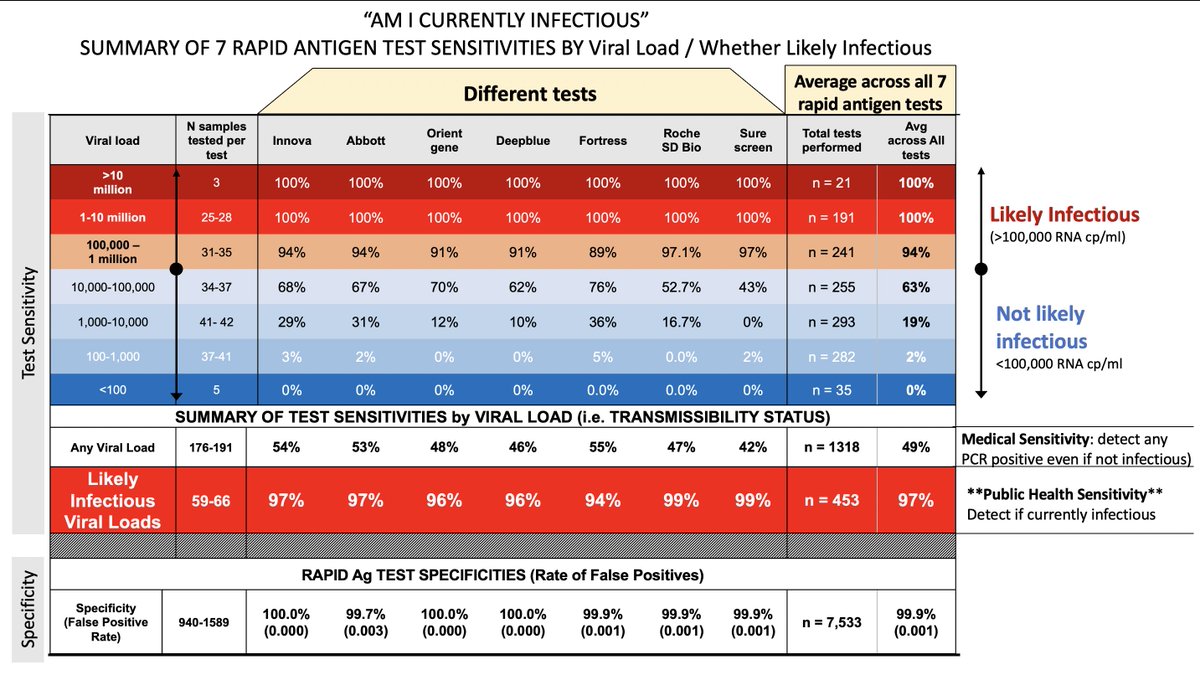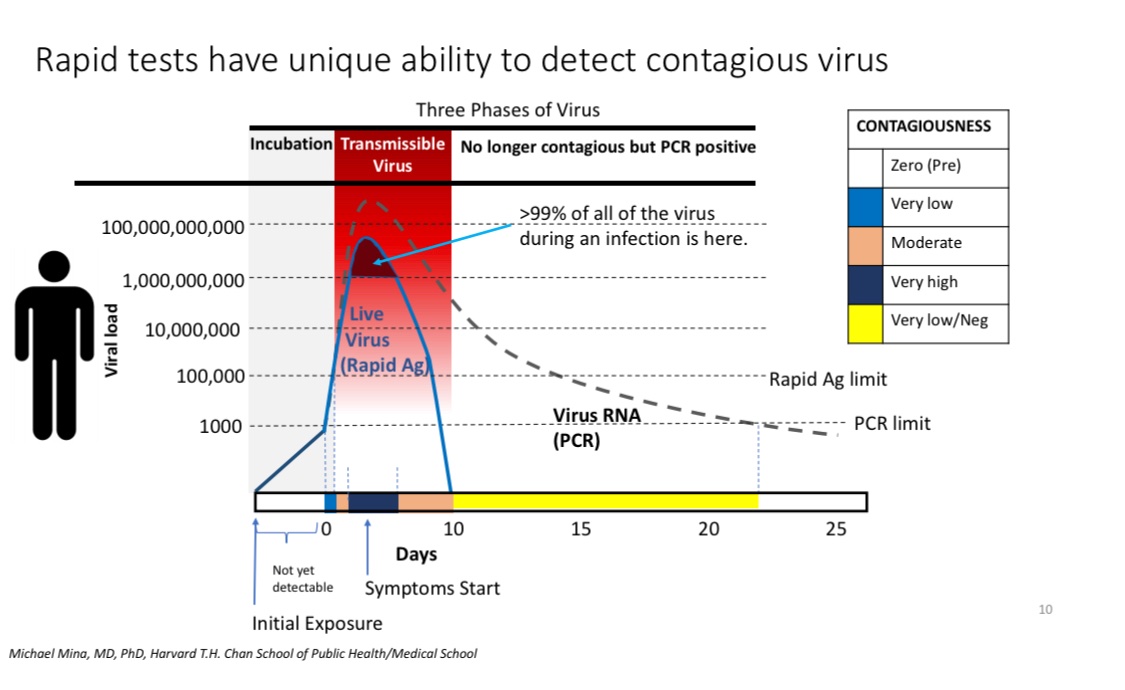
1/ Thread
While vaccines are most effective tool to protect us all from severe disease
#RapidTests answering “Am I Infectious Now?” are an answer to society *living* with Covid-19
New @NYTOpinion @nytimes by me and Steven Philips @TheCOVIDCollab
nytimes.com/2021/10/01/opi…
While vaccines are most effective tool to protect us all from severe disease
#RapidTests answering “Am I Infectious Now?” are an answer to society *living* with Covid-19
New @NYTOpinion @nytimes by me and Steven Philips @TheCOVIDCollab
nytimes.com/2021/10/01/opi…
@nytopinion @nytimes @TheCOVIDCollab 2/
FINALLY Americans are seeing the value of at-home rapid tests, and demanding them to help keep their families, friends, neighbors safe and schools and businesses running.
But now the US govt needs to make more highly accurate rapid tests available to meet that demand.
FINALLY Americans are seeing the value of at-home rapid tests, and demanding them to help keep their families, friends, neighbors safe and schools and businesses running.
But now the US govt needs to make more highly accurate rapid tests available to meet that demand.
@nytopinion @nytimes @TheCOVIDCollab 3/
In many parts of world, rapid testing is commonplace. Policymakers recognized early that rapid tests could blunt the pandemic by scuttling transmission chains. They created special regulatory pathways to evaluate these tests, quickly & effectively
nytimes.com/2021/06/09/wor….
In many parts of world, rapid testing is commonplace. Policymakers recognized early that rapid tests could blunt the pandemic by scuttling transmission chains. They created special regulatory pathways to evaluate these tests, quickly & effectively
nytimes.com/2021/06/09/wor….
@nytopinion @nytimes @TheCOVIDCollab 4/
In the US, our already overburdened regulatory authorities have had an impossible task – evaluate a tool meant for public health as a medical device. Its clear that the US should follow in Europe’s footsteps & stand up a public health evaluation track to evaluate rapid tests.
In the US, our already overburdened regulatory authorities have had an impossible task – evaluate a tool meant for public health as a medical device. Its clear that the US should follow in Europe’s footsteps & stand up a public health evaluation track to evaluate rapid tests.
@nytopinion @nytimes @TheCOVIDCollab 5/
@POTUS already gave his public health directive to the country – vaccinate or weekly testing
Now he should use executive power to designate rapid tests as the public health tools they are, to regulate them appropriately for their public health transmission stopping benefits
@POTUS already gave his public health directive to the country – vaccinate or weekly testing
Now he should use executive power to designate rapid tests as the public health tools they are, to regulate them appropriately for their public health transmission stopping benefits
@nytopinion @nytimes @TheCOVIDCollab @POTUS 6/
5/
Frequent rapid testing especially in schools is one of the best ways to keep kids in schools. We can avoid unnecessary quarantines by using highly accurate rapid tests.
nytimes.com/2021/09/19/hea…
5/
Frequent rapid testing especially in schools is one of the best ways to keep kids in schools. We can avoid unnecessary quarantines by using highly accurate rapid tests.
nytimes.com/2021/09/19/hea…
@nytopinion @nytimes @TheCOVIDCollab @POTUS 7/
The vaccines were developed and deployed successfully because of Operation Warp Speed. We need the same prioritization and focus for rapid tests.
time.com/6096528/operat…
The vaccines were developed and deployed successfully because of Operation Warp Speed. We need the same prioritization and focus for rapid tests.
time.com/6096528/operat…
@nytopinion @nytimes @TheCOVIDCollab @POTUS 8/
The highly contagious Delta variant makes knowing your Covid status in real- time more important than ever. We need to ensure that the U.S. has enough supply and that all Americans have free access to these powerful public health tools.
The highly contagious Delta variant makes knowing your Covid status in real- time more important than ever. We need to ensure that the U.S. has enough supply and that all Americans have free access to these powerful public health tools.
@nytopinion @nytimes @TheCOVIDCollab @POTUS 9/
And with new treatments and therapies coming out that must be started SOON after symptoms, we need to ensure people have both ready access to tests when they need them, and get fast results, from home
Especially rural US where lab testing far too slow
And with new treatments and therapies coming out that must be started SOON after symptoms, we need to ensure people have both ready access to tests when they need them, and get fast results, from home
Especially rural US where lab testing far too slow
https://twitter.com/michaelmina_lab/status/1443943752142295042?s=20
@nytopinion @nytimes @TheCOVIDCollab @POTUS 10/
Of course, thank you to the many public health experts who have advocated for rapid tests with us. Together we can change the system.
The path to increase access is charted.
Now it’s on USGov / president to make this happen.
@ashishkjha @EricTopol @WHCOS @CarlosdelRio7
Of course, thank you to the many public health experts who have advocated for rapid tests with us. Together we can change the system.
The path to increase access is charted.
Now it’s on USGov / president to make this happen.
@ashishkjha @EricTopol @WHCOS @CarlosdelRio7
Also, this notion isn’t new (as anyone who follows me on this platform knows)
We were discussing this early 2020. Here is. @nytimes @nytopinion piece @Kotlikoff and I wrote middle of 2020
nytimes.com/2020/07/03/opi…
We were discussing this early 2020. Here is. @nytimes @nytopinion piece @Kotlikoff and I wrote middle of 2020
nytimes.com/2020/07/03/opi…
• • •
Missing some Tweet in this thread? You can try to
force a refresh





